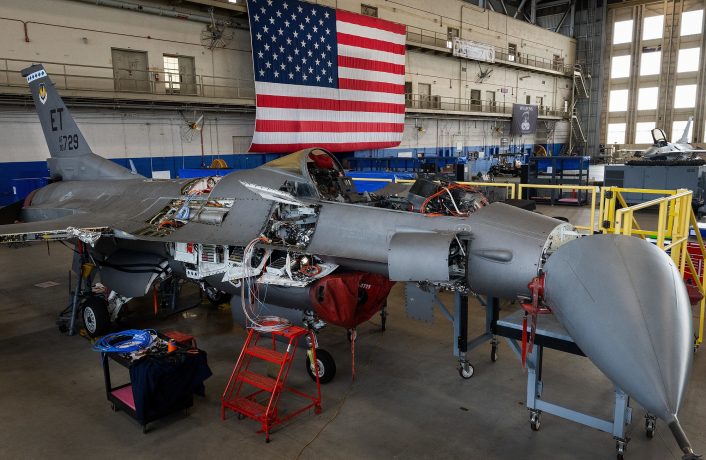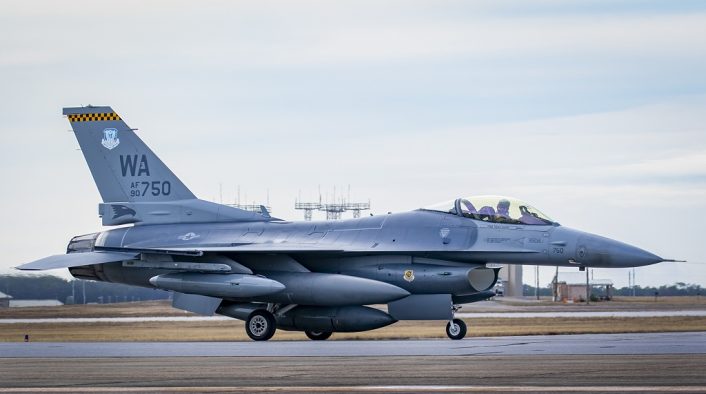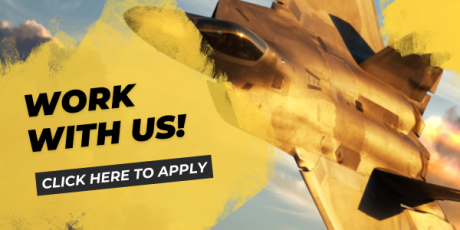The VENOM program will modify six F-16Cs into autonomous aircraft to accelerate testing of autonomy software on crewed and uncrewed aircraft.
The U.S. Air Force is progressing with the Viper Experimentation and Next-gen Operations Model – Autonomy Flying Testbed program, or VENOM, which will modify six F-16Cs into autonomous aircraft. On Apr. 1, 2025, the last aircraft set for modification arrived at Eglin Air Force Base, Florida.
Integrating autonomy into the F-16
The first three Vipers arrived at Eglin last year in April and are currently undergoing software, hardware and instrumentation modifications that will eventually allow the autonomy agents to fly the aircraft. A physical change mentioned by the service is the inclusion of an auto-throttle, which would allow the autonomy to regulate the thrust, while the flight control surfaces would be handled by the Flight Control System’s computer.
“Modifying the aircraft is the result of a rigorous design phase and brings us one step closer to testing autonomy on a fighter jet with real mission systems and capabilities,” said Maj. Trent McMullen, the 40th Flight Test Squadron’s advanced capabilities division chief.
While modifications are being made to the aircraft, the autonomy system “is continuously tested in faster-than-real-time modelling and simulation environments in countless aircraft combat scenarios,“ said the service. The press release further mentions that “simulations began in 2024 and included one-on-one and now two-on-two combat flights,” which also include “within-visual-range and beyond-visual-range missions.”
“These simulations provide an efficient way to train the autonomy to learn complex air combat tactics.” said McMullen. “A specific scenario can be run 1,000 times and the variations and decisions made throughout that mission can be studied. We can then make recommendations to the developers on how to improve the autonomy’s behaviors and overall performance.”

The press release also described the next steps of the VENOM program, which involve hardware and software-in-the-loop testing, the latter conducted in the simulator. For the software, the goal is to ensure the VENOM autonomy connects to and communicates with the aircraft’s system, while the goal for the hardware is to ensure the autonomy can’t go past its limits or exceed its flight envelope, thus ensuring the safety.
In the end, this testing will confirm autonomous commands cannot break the aircraft or pilot, according to McMullen, as well as examine how to manage aggressive aircraft maneuvers that are within the pilot’s physical and physiological safety limits. In fact, once VENOM moves to flight testing, a test pilot will be on board to oversee the flight with the ability to start and stop the autonomy in real time.
Once the software and hardware tests are examined and cleared, the VENOM program will move to ground testing with a fully modified F-16, said the service. To expedite the program, similarly to most F-16 and F-15 testing at Eglin, the VENOM program will undergo simultaneous developmental and operational testing.
“Having both DT and OT pilots working and flying from the same location allows for daily collaboration and reduces the stove piping of knowledge and lessons learned,” said Lt. Col. Jeremy Castor, VENOM operational test lead.
Because of these efforts, the service says that the first fully modified aircraft will possibly be ready to begin testing within only 18 months of the first F-16s arriving at Eglin. This would put the start date of the testing in October 2025.
“As the VENOM program’s first flight approaches, we are excited to test novel autonomous solutions. The strides we’ve witnessed in the simulation environment suggest VENOM will help advance aerial combat capabilities for future crewed and uncrewed platforms,” said McMullen.

What is VENOM
VENOM-AFT, or Viper Experimentation and Next-gen Operations Model – Autonomy Flying Testbed, is a program designed and funded to accelerate testing of autonomy software on crewed and uncrewed aircraft, complementing the Autonomy Data and AI Experimentation proving ground at Eglin and informing the Collaborative Combat Aircraft program and other autonomy developers.
“The VENOM program marks a pivotal chapter in the advancement of aerial combat capabilities. This transformative program holds the potential to redefine air combat paradigms by fostering novel autonomous functions for current and future crewed and uncrewed platforms,” said last year Maj. Ross Elder, VENOM developmental test lead. “We look forward to the culmination of years of engineering and collaboration, as VENOM leads a measured step towards a new age of aviation.”
A total of six F-16Cs will be modified into test platforms to rapidly evaluate autonomous capabilities and undergo developmental and operational testing via the 40th Flight Test Squadron and the 85th Test and Evaluation Squadron. The aircraft, however, will not be a crewless drone like the QF-16, as pilots will always be in the cockpit to monitor the autonomy and ensure flight and mission systems test objectives are met.
“It’s important to understand the ‘human-on-the-loop’ aspect of this type of testing, meaning that a pilot will be involved in the autonomy in real time and maintain the ability to start and stop specific algorithms,” said Lt. Col. Joe Gagnon, 85th TES commander when the first aircraft arrived at Eglin. “There will never be a time where the VENOM aircraft will solely ‘fly by itself’ without a human component.”









